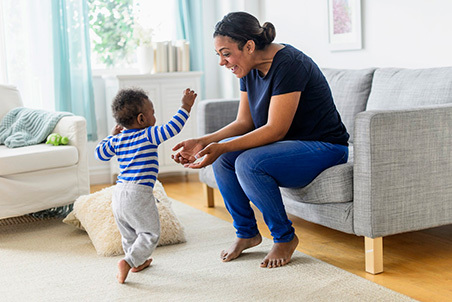
Safety is about more than just alarm systems. Check out our five key areas to prioritize for peace of mind in your home.
The desire for comfort and consistency motivates many to consider homeownership, and that’s feeling more pertinent now than ever! Economic uncertainty, a global pandemic, and the effects of climate change may make it difficult to feel safe and secure. While it’s not all gloomy news, most of us have now become accustomed to spending more time in our homes – which have taken on new roles as workplaces, classrooms, gyms, and bakeries!
If you do find yourself thinking more about how to make your home feel like a safe haven, you’re not alone. Safety extends past Home Alone-style burgling to a variety of factors that impact the physical, mental, and emotional wellbeing of your household. By reflecting more broadly on the concept of safety, you can implement common-sense solutions that will make your whole family more comfortable and secure. Here are five ways you might want to think about safety at home:
1. Crime Prevention
The first thing you probably think of when you consider safety is protection from intruders. You may consider living in a gated community or doorman building, as well as home security technology implementation, which has gotten much “smarter” in recent years. Some areas to consider are monitored alarm systems, panic buttons, security cameras, and smart locks.
Awareness of your neighbors and neighborhood are just as critical. Some helpful first steps to ensure a safe community:
- Get to know your neighbors
- Find community organizations like neighborhood watch or your homeowner’s association
- Pay attention to your surroundings when leaving or arriving home
2. Cybersecurity
Identity protection once consisted primarily of document shredding and disposal. While document protection is still important, the prevalence of modern smart-home devices means that cybersecurity is critical. Criminals remotely access smart locks for unauthorized entry and learn details about a homeowner’s finances through email hacks.
Fortunately, instituting basic cybersecurity measures can be as easy as keeping smart devices and operating systems updated. Manufacturers consistently respond to new threats with security improvements, and most software updates include security patches. You should go the extra mile with regular password changes, a security-focused password manager, and two-factor authentication where possible.
3. Safety Monitoring
Potential dangers do not all come from outside. Safety monitoring within the home can be just as important and lifesaving. Ensuring that smoke and carbon monoxide detectors are operational and that backup batteries are replaced frequently can provide peace of mind.
Some homeowners also choose to install weather monitoring systems to warn of dangerous conditions, especially with the rise of extreme weather. For example, you might want to consider water intrusion monitoring equipment or wildlife detectors, depending on your regional concerns.
4. Physical Accessibility
According to the National Safety Council, the rate of preventable injury-related deaths occurring in or around the home has increased by a whopping 150 percent since 1999. The CDC compiled a great home safety checklist for older adults to be sure they’re avoiding injury in their day to day. A lot of the pointers are helpful for the younger among us as well – particularly if prone to klutzy moments…we’ve all been there! Consider:
- Installing grab bars in tubs and showers, especially if the tile flooring tends to be slippery
- Adding secure handrails on both interior and exterior stairways
- Ensuring you have adequate lighting (including nightlights), especially around staircases
- Clearing staircases and walkways indoors of toys and leaves, debris, snow, and ice outdoors
- Installing alarms, locks, and/or covers on recreational equipment such as pools, hot tubs, and trampolines
5. Environmental Safety
Indoor air quality can significantly impact your family’s health and safety. According to the EPA, indoor air pollutants can cause health problems ranging from irritation of the respiratory system to more serious conditions such as heart disease and cancer. Fear not: you can take steps to ensure your family is safe from air pollution and other household toxins:
- Have your home tested for radon, a colorless, odorless radioactive gas present in nearly all soils that has detrimental health effects
- Avoid using pesticides indoors and outdoors and substitute smart planting and pruning strategies to keep your landscaping in shape
- Reduce your plastic use, especially when it comes to food storage and preparation, and drink from your tap (filtered, if needed!) rather than from plastic bottles
- Consider using non-toxic and even DIY cleaning products throughout your home
- Eat organic and unprocessed foods as much as possible
- Look for natural ingredients for skin and body care items, and avoid toxic chemicals
- As we all know from the pandemic, wash your hands!
Making your home safer, healthier and more secure provides added peace of mind and helps you truly enjoy your time at home. After all, for most people, the home is their single biggest investment, both in terms of time and money.
Looking for peace of mind when it comes to securing a mortgage, too? Check out Simplist – our loan experts, plus our array of more than 50,000 loan options can help you feel better about your mortgage experience –whether you’re looking for a pre-approval, purchase, or refinance.